
Postmodern architecture style in Buffalo
Alternate
Postmodern spellings: Post Modern,
Post-Modern
Late 20th Century
|
Children's
Hospital (Bryant Street)
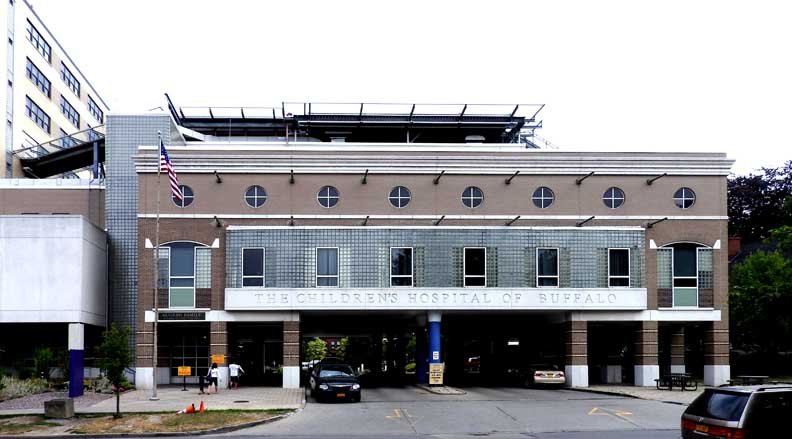 Children's Hospital (Bryant Street) 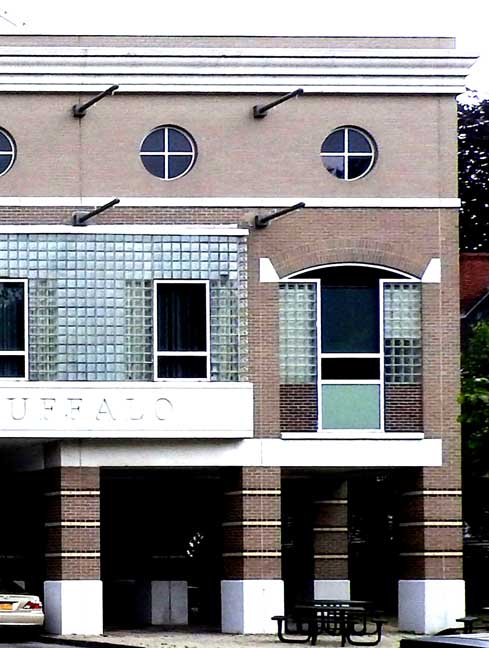 Children's Hospital (Bryant Street) Postmodern classical features (top down): Cornice ... Frieze with decorative round windows ... Stringcourse ... Segmental arch ... Brick pillars that reference banded columns ... Color "In
my opinion the entry pavilion at Children's Hospital is the
best post-modern building in Buffalo."- Anthony O. James, architect
|
| William Hengerer
Company / Lafayette Court 465 Main Street 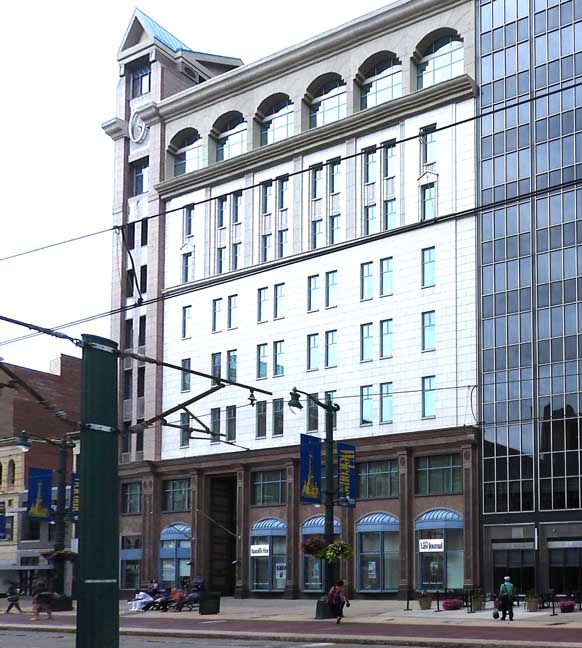 William Hengerer Company / Lafayette Court 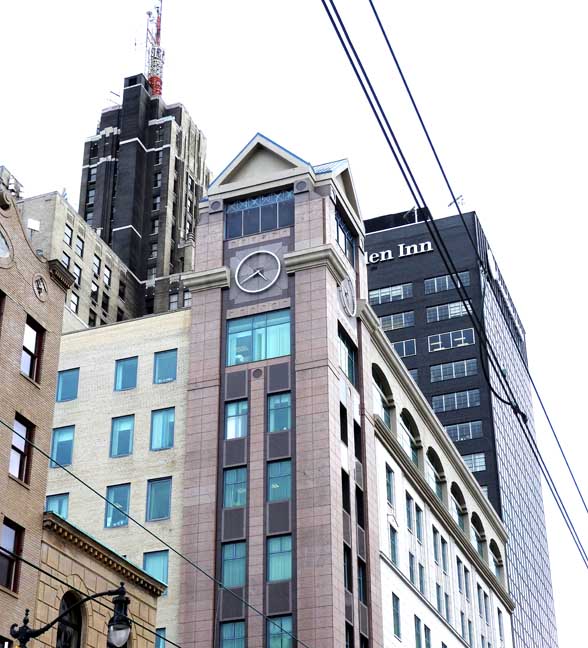 William Hengerer Company / Lafayette Court Postmodern features: Tower with gable roof ... Clock ... Arches ... Color 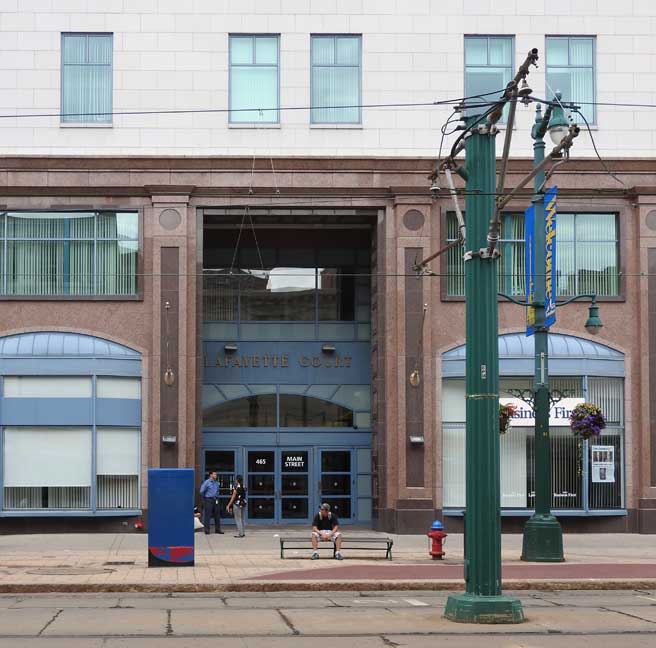 William Hengerer Company / Lafayette Court Postmodern features: Entrance stylized pilasters ... Bay windows |
| Perry Homes Extension 254 Perry Street 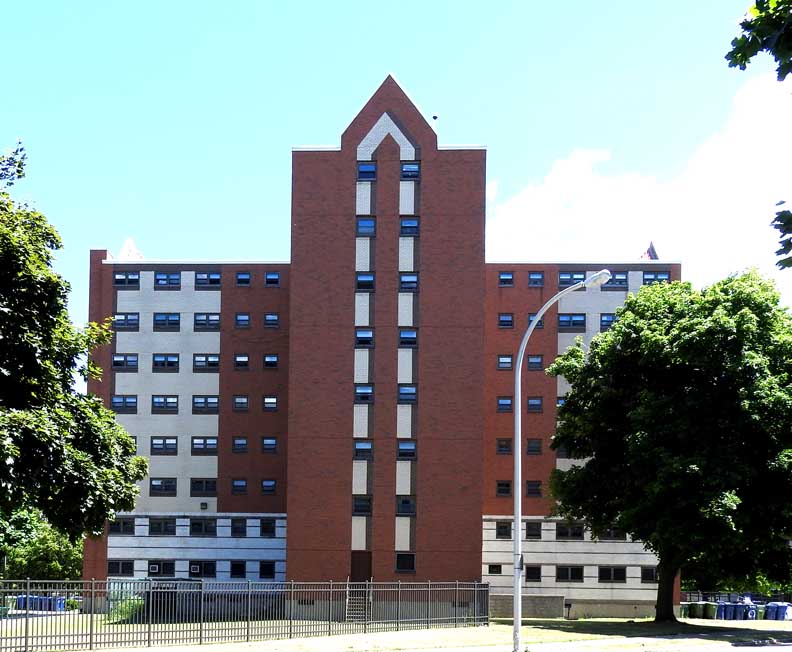 Perry Homes Extension Postmodern features: Gable roof ... Color |
| Buffalo Bisons
Baseball Stadium 1988 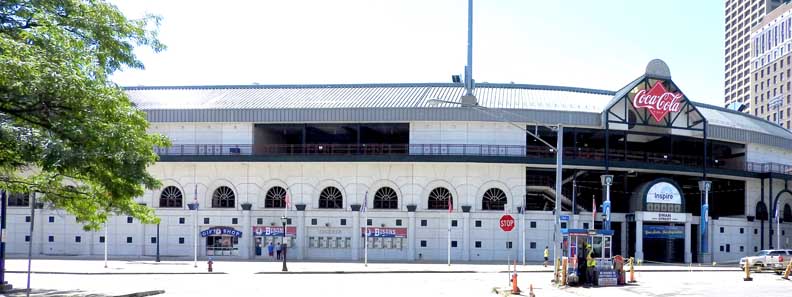 Buffalo Bisons Baseball Stadium 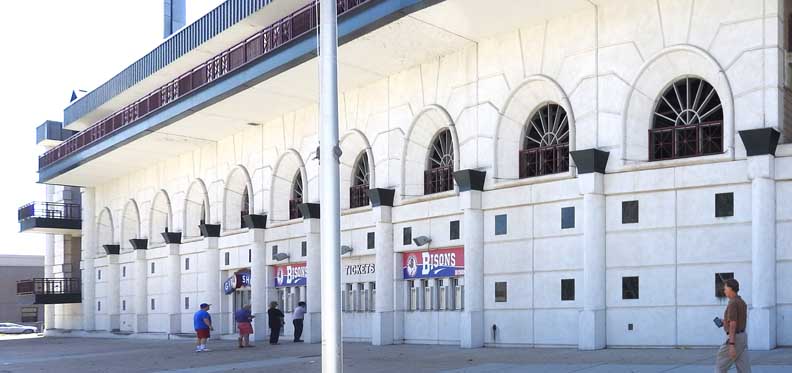 Postmodern features: Arches and columns are a clear reference to Roman colosseums |
Key Center at
Fountain Plaza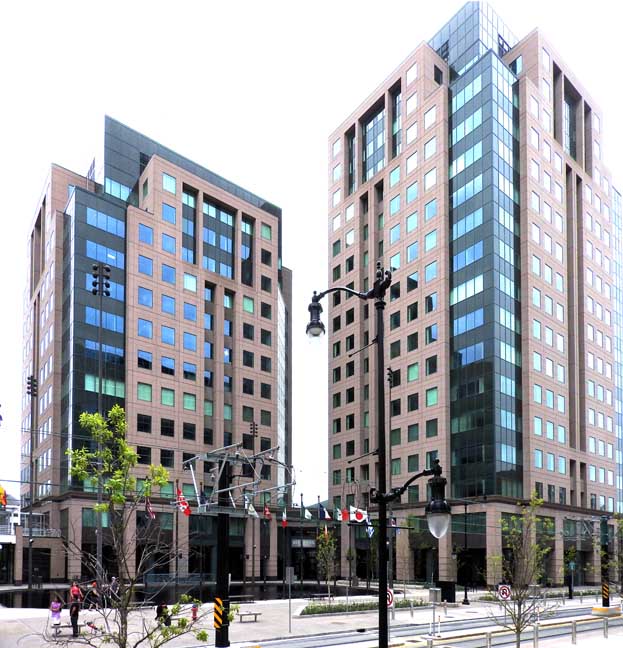 Key Center at Fountain Plaza 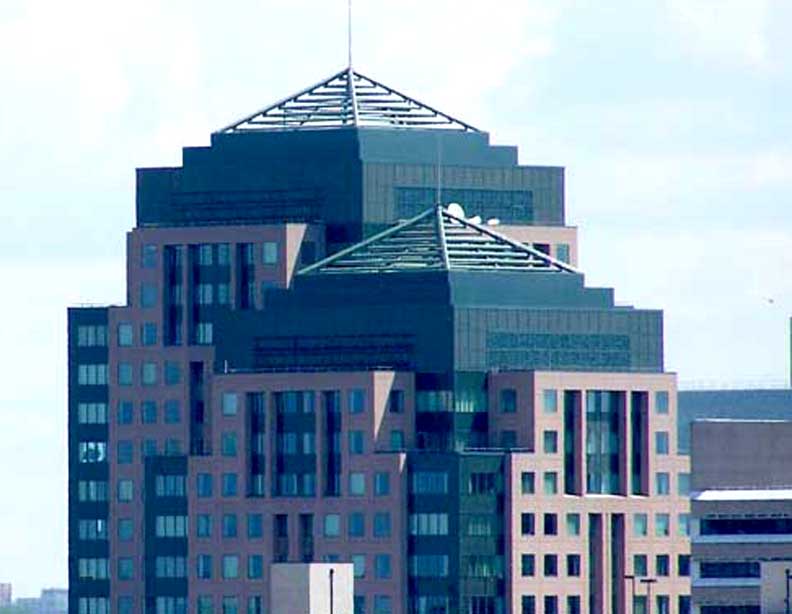 Key Center at Fountain Plaza Postmodern features: Step gable pyramidal roofs ... Color |
Burt Flickinger Athletic Center 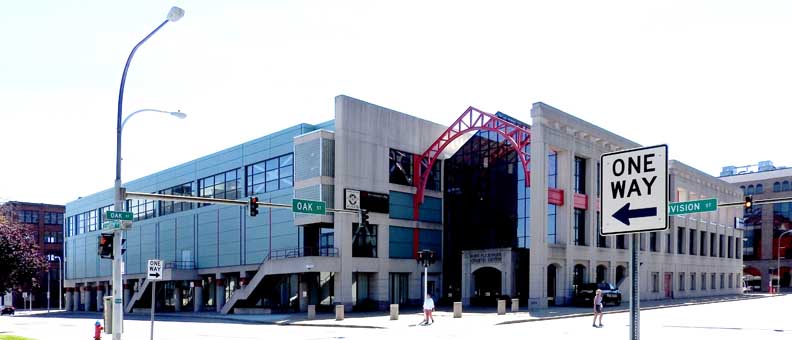 Burt Flickinger Athletic Center 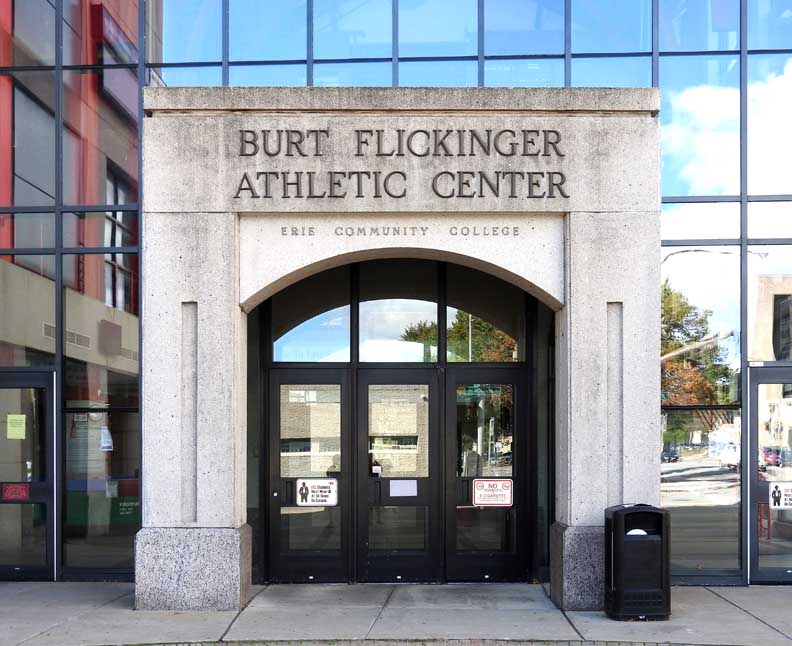 Postmodern features: Cornice ... Frieze ... Segmental arch ... Transom window 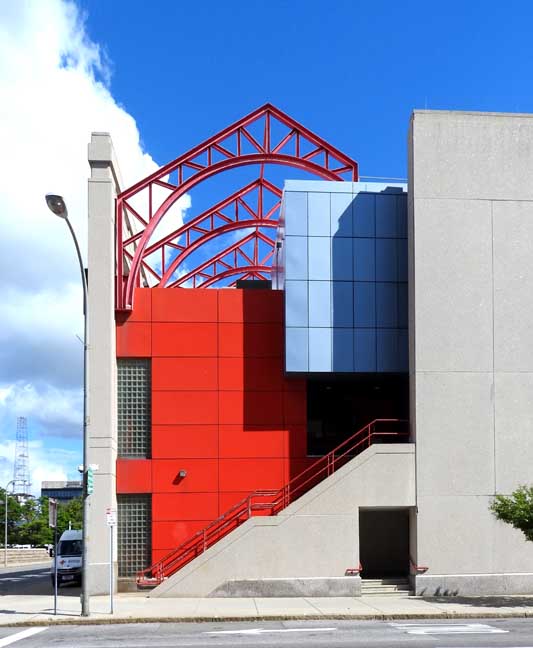 Postmodern features: Bright red trusses with an arched bottom chord used decoratively ... Color |
1983 Goldome
Addition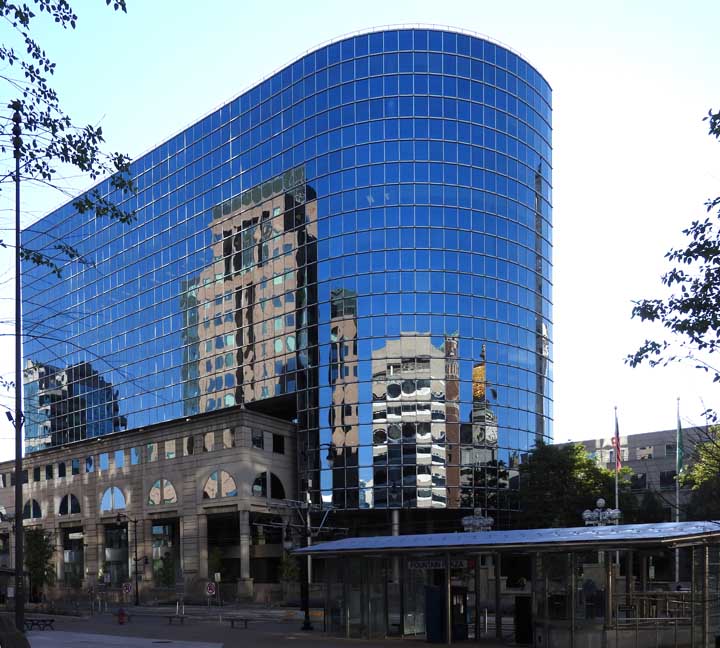 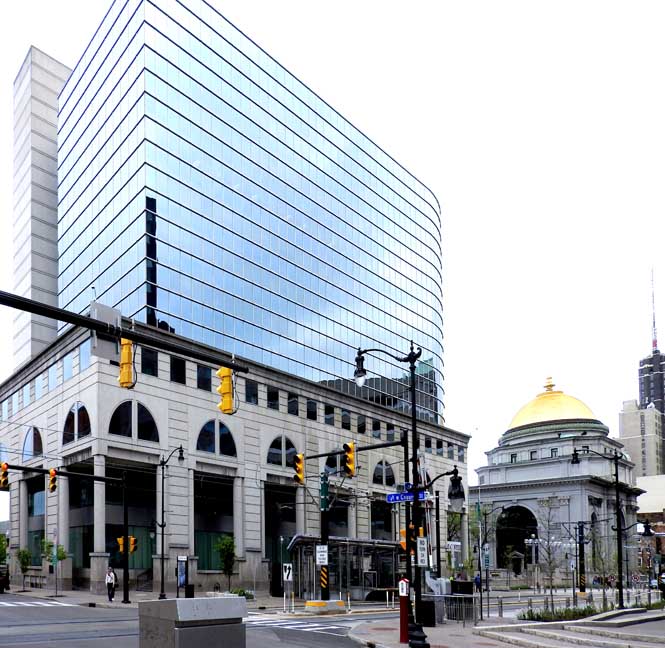 Postmodern features: Rounded windows ... Columns ... Rustication |
City Centre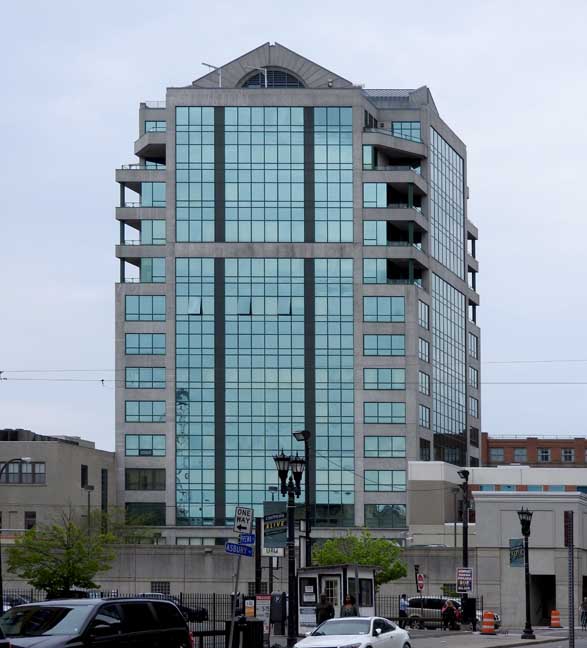  Postmodern features: Broken pediment ... Balconies ... Stringcourse ... Colored glass |
| US Post Office 229 West Genesee St.  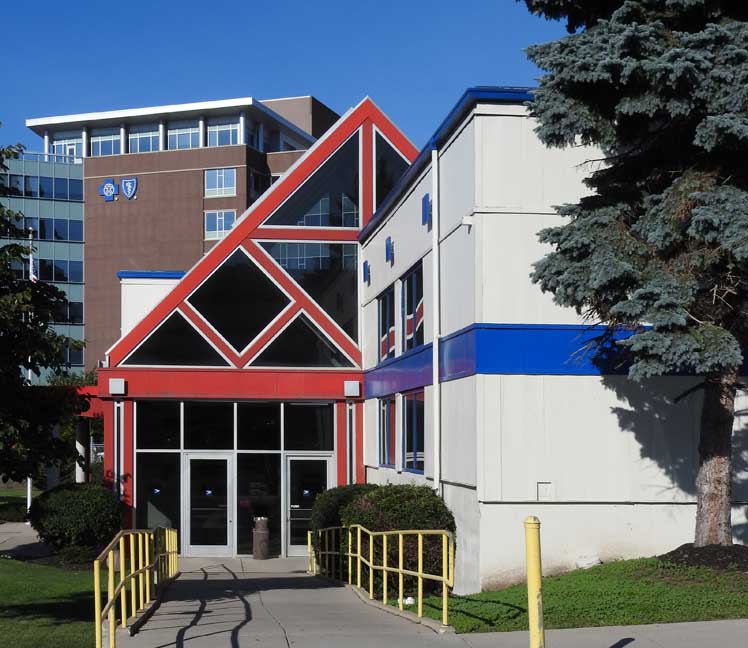 Postmodern features: Gable roof ... King post ... Color .... Stringcourse 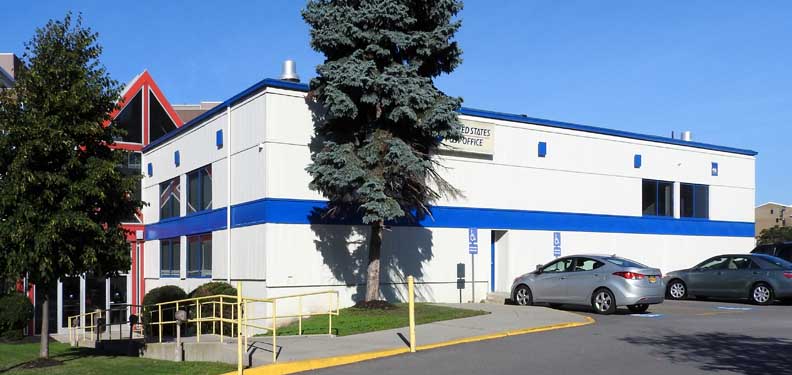 |
Sabres Arena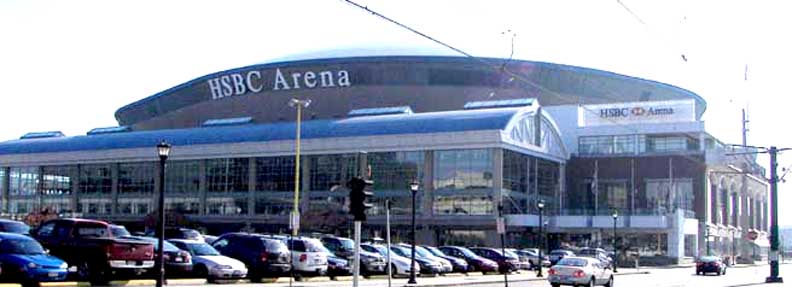 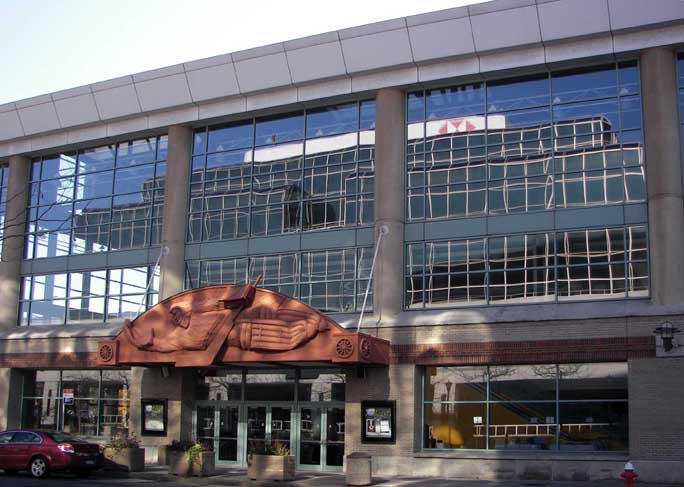 Postmodern features: Bas-relief sculpture of a hockey goalie ... Color  Postmodern feature: A sailing ship's "crow's nest" is part of the waterfront motif that is found on the exterior and in the interior |
Hyatt Regency-Buffalo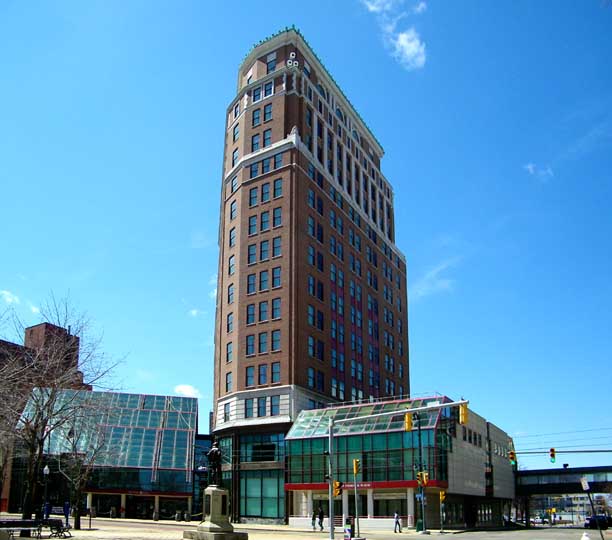 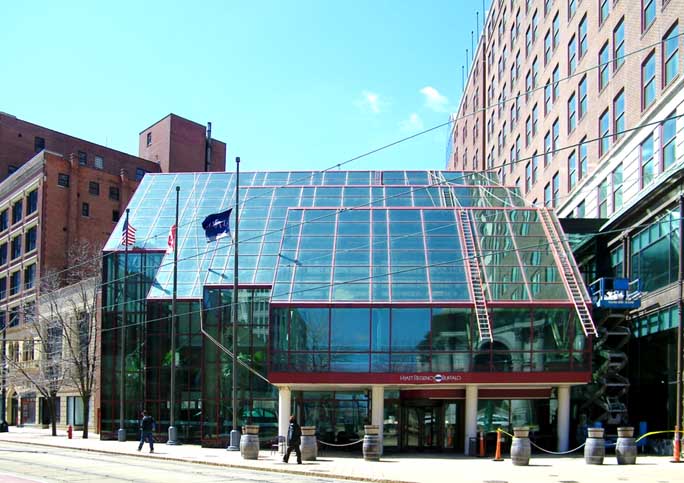 Postmodern features: Shed roofs ... color 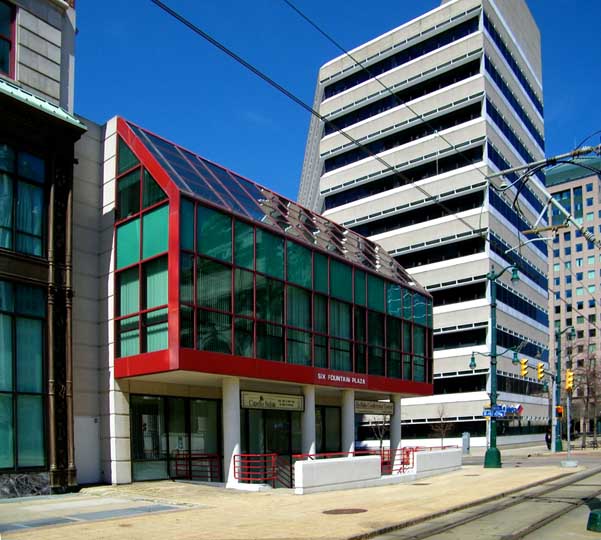 Postmodern features: Shed roofs ... Color ... Pillars 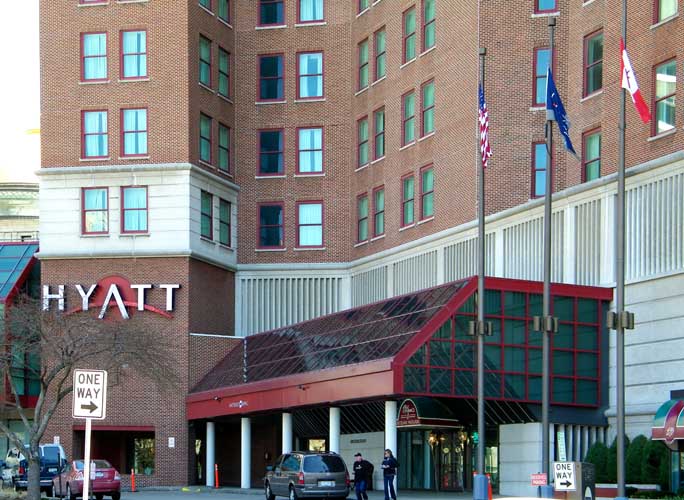 |
Barnes
& Hengerer Building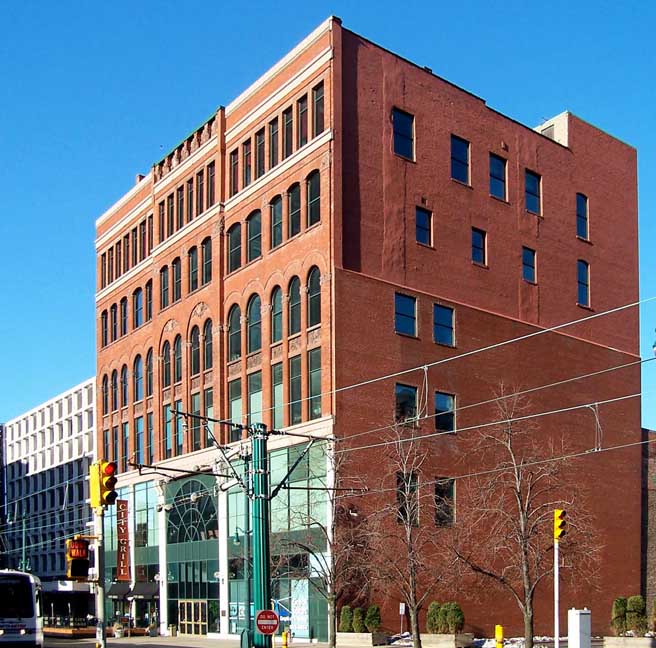 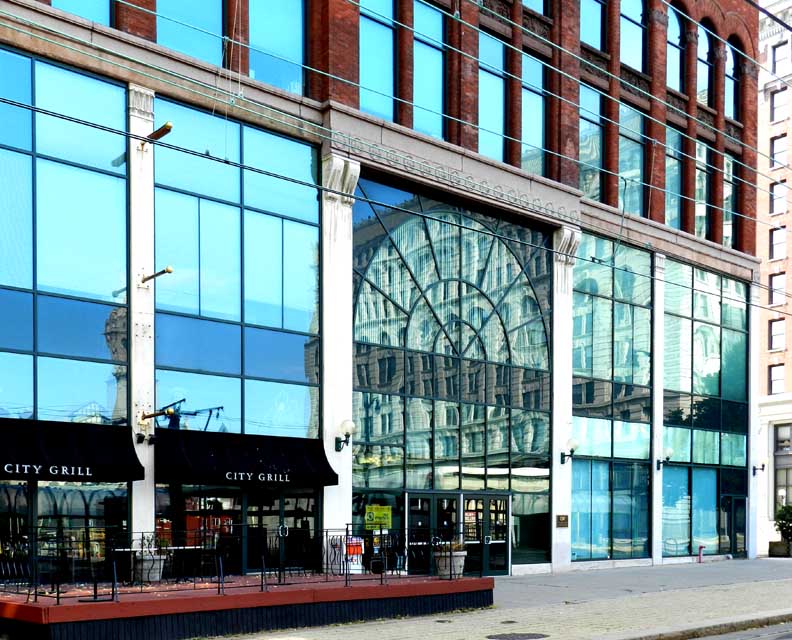 Postmodern features: Color ... Fanlight ... Ancones ... Pilasters |
| Light Rail Rapid Transit System Dedicated 1985 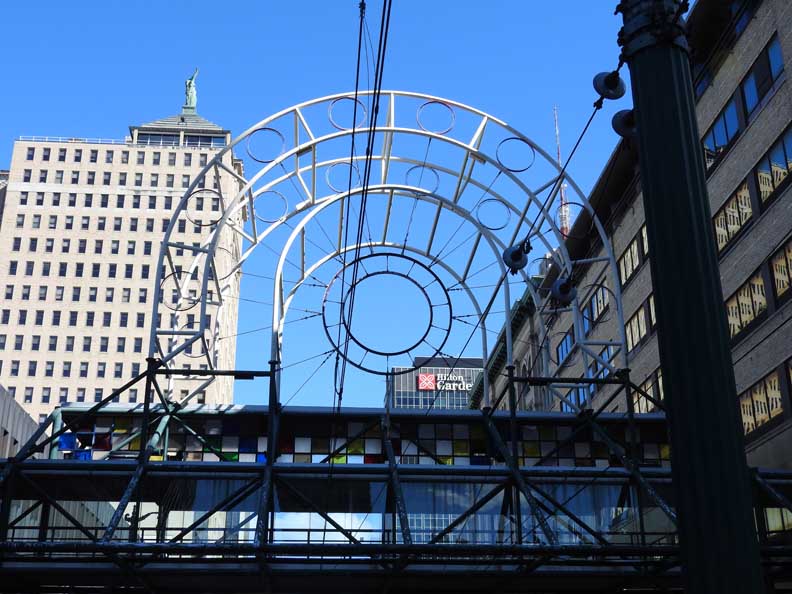 Bridge between AM&A's and the Main Place Mall Postmodern features: Color ... Compound arch |
Outside of Buffalo:
|
|
Post Modernists indirectly imitate many historical styles, ... use ornament and often mix various styles and periods from different cultures. - Lester Walker, American Homes: The Illustrated Encyclopedia of Domestic Architecture, 1981, p. 304 |
| A reaction to the Modern style
was Postmodernism which developed in the
1950s. It reintroduces color and symbolism to architecture, replacing the aggressively unornamented modern styles. A prime example of inspiration for postmodern architecture lies along the Las Vegas Strip. Postmodern architects often regard modern spaces as soulless and bland, and instead sees exuberance in the use of building techniques, angles, and stylistic references. - James Stevens Curl, The Egyptian Revival: Glossary - Capitals (2005) |
|
One building form that typifies the explorations of Postmodernism is the traditional gable roof, in place of the iconic flat roof of modernism. Shedding water away from the center of the building, such a roof form always served a functional purpose in climates with rain and snow, and was a logical way to achieve larger spans with shorter structural members, but it was nevertheless relatively rare in modern houses. A vivid example of this new approach was that Postmodernism saw the comeback of columns and other elements of premodern designs, sometimes adapting classical Greek and Roman examples (but not simply recreating them, as was done in neoclassical architecture). In Modernism, the traditional column (as a design feature) was treated as a cylindrical pipe form, replaced by other technological means such as cantilevers, or masked completely by curtain wall facades. The revival of the column was an aesthetic, rather than a technological, necessity. Roots of Postmodernism The Postmodernist movement began in America around the 1960s - 1970s and then it spread to Europe and the rest of the world, to remain right through to the present. The aims of Postmodernism or Late-modernism begin with its reaction to Modernism; it tries to address the limitations of its predecessor. The list of aims is extended to include communicating ideas with the public often in a then humorous or witty way. Often, the communication is done by quoting extensively from past architectural styles, often many at once. Many felt the buildings failed to meet the human need for comfort both for body and for the eye, that modernism did not account for the desire for beauty. The problem worsened when some already monotonous apartment blocks degenerated into slums. In response, architects sought to reintroduce ornament, color, decoration and human scale to buildings. |
|
What is Postmodernist Architecture?
Excerpt from Encyclopedia of Art and Design: American Architecture (online June 2016) [Jane] Jacobs and [Robert] Venturi were catalysts for a wave of opposition to Modernism, but they didn't invent "Postmodernism". The term was actually coined by the American theorist Charles Jenks in his book The Language of Post-Modern Architecture (1977), which describes the architectural tendencies that sprang up in the 60s in opposition to the dominant dictates of rationalist modernism. The point was, modern architecture had excluded traditional historic forms as well as decorative elements from its repertory. Postmodernism wanted to "rehumanize" architecture by using a mixture of styles, including features taken from classical designs as well as those from popular culture. Playful irony, plus occasional surprises, even shocks, have all been an essential part of the postmodernist approach to building design. After all, basic features of architecture, like columns, arches, and tympana, often lose their original meaning when used out of context - say, as decorative elements. |
| Postmodern
architecture elements that link with past languages of architecture and
historicist recollections: Arches ... Columns ... Base, shaft, capital ... Domes (Roman and derivatives) ... Colonnade ... Pediments ... Broken pediments (Michaelangelo) ... Arcade ... Triumphal arch ... Keystone ... Grand public staircase ... Asymmetrical (Queen Anne) ... Pitched roof (Gothic) ... Stringcourse ... Lunette window ... Palladian window ... Setbacks (Art Deco) ... Bow window ... Local vernaculars ... Strong reds, yellows, blues, oranges ... Parapet ... Flowerburst ... Quoins ... Balconies ... Crow steps ... Stepped motif - Culled from Charles Jencks, "Architecture Today," 1988, Harry N. Abrams, Inc. |